Interview with Janet Shamlian, CBS News
Janet Shamlian with CBS News interviewed me about my Totality Addiction – 20 eclipses and counting.
I hope my messages of “Get into the Path” and “No Child Left Inside” make it into the broadcast. Look for this from CBS in the week leading up the Texas Solar Eclipse on April 08 2024.
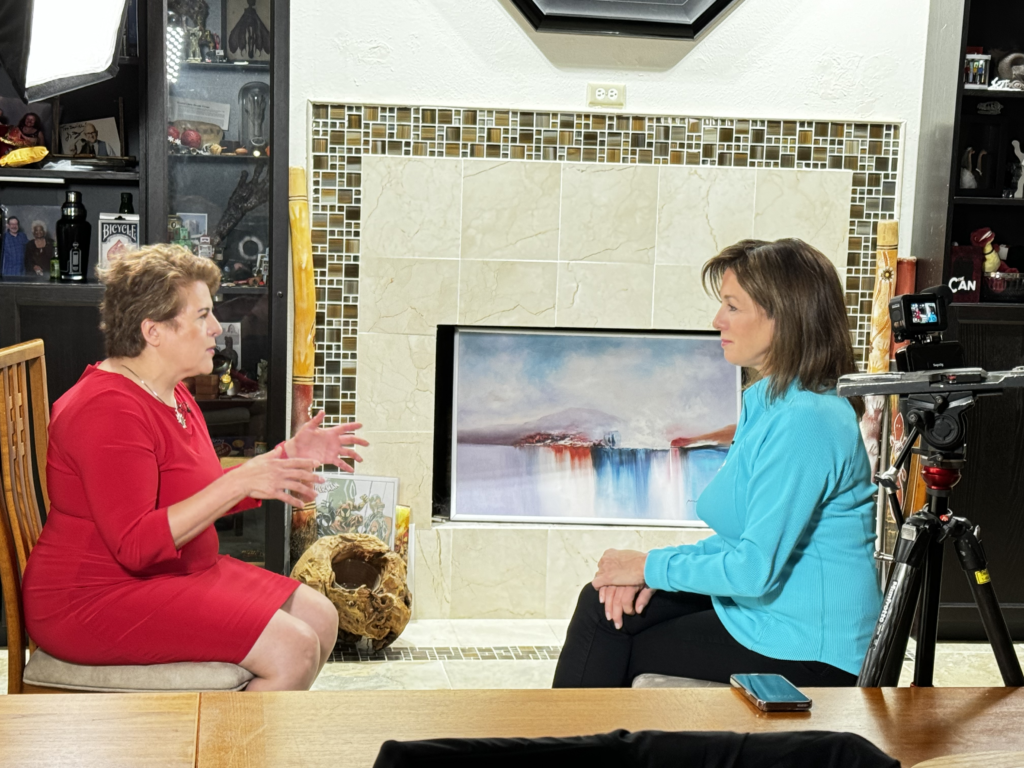
Get into the Path!
Great Article by Angela Speck on the different between 99.9% Partial and a Total Solar Eclipse. Denton, Sherman/Denison and Weatherford are not in the path.
https://sciences.utsa.edu/physics-astronomy/eclipse.html
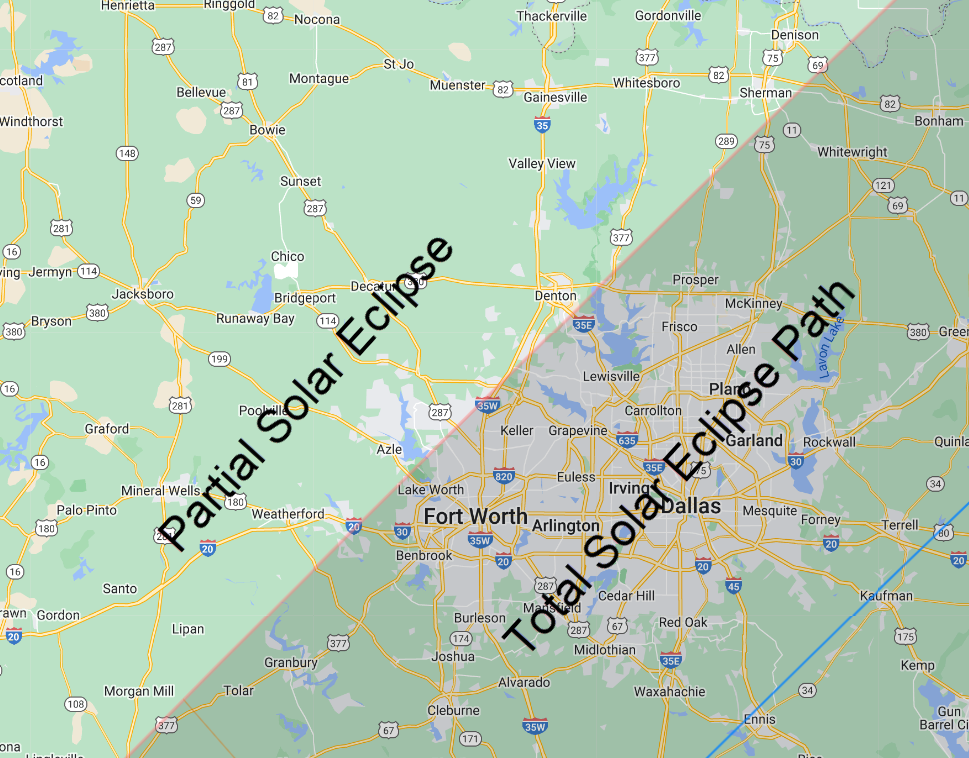
Remember to get in the path. For an interactive Google Map go to: xjubier.free.fr/tse2024map.
Still need your glasses to see the eclipse safely, you can get them at https://texassolareclipses.com/store/
Our Interview with Jamie Carter
Our interview with Jamie Carter is out. We had a great moment, when I went off to get my “Eclipse Globe”, then Jamie and Chris also pulled out their globes.
One of the advantages and addictive parts of Total Solar Eclipse chasing is planning for the next ones and seeing all the cool places on earth.
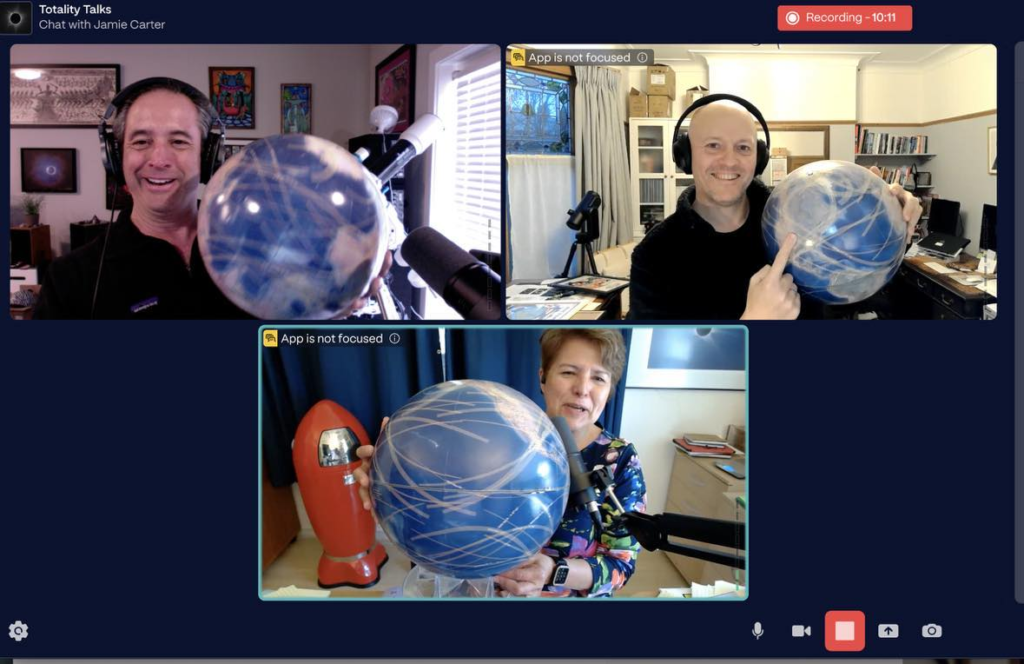

“Ring of Fire” Annular Solar Eclipse Will Cross Texas October 14 2023
All of Texas will see at least a deep partial Solar Eclipse of at least 80% Coverage of the Sun by the Moon. Key Cities in the path of Annularity – that will see the “Ring of Fire” are Midland/Odessa, San Angelo, Kerrville, San Antonio and Corpus Christi.
The “Ring of Fire” Solar Eclipse is not as dramatic as the Total Solar Eclipse of April 08 2024, but it still is a great example of the Wonder of Science and Astronomy. The light we get “eerie” or weird once the moon covers about 80% of the sun. Look for half moons in the shadows of trees. As of now all of Texas is in for Clear Skies, so protect your eyes, as if you can view the solar eclipse safely.
Times are estimates as they differ based on your location in Texas. But roughly.
Start of Partial: Sat, Oct 14, 2023 at 9:14 am MDT
Start of Annularity: Sat, Oct 14, 2023 at 11:41 am CDT (if in the path)
End of Annularity: Sat, Oct 14, 2023 at 12:01 pm CDT (if in the path)
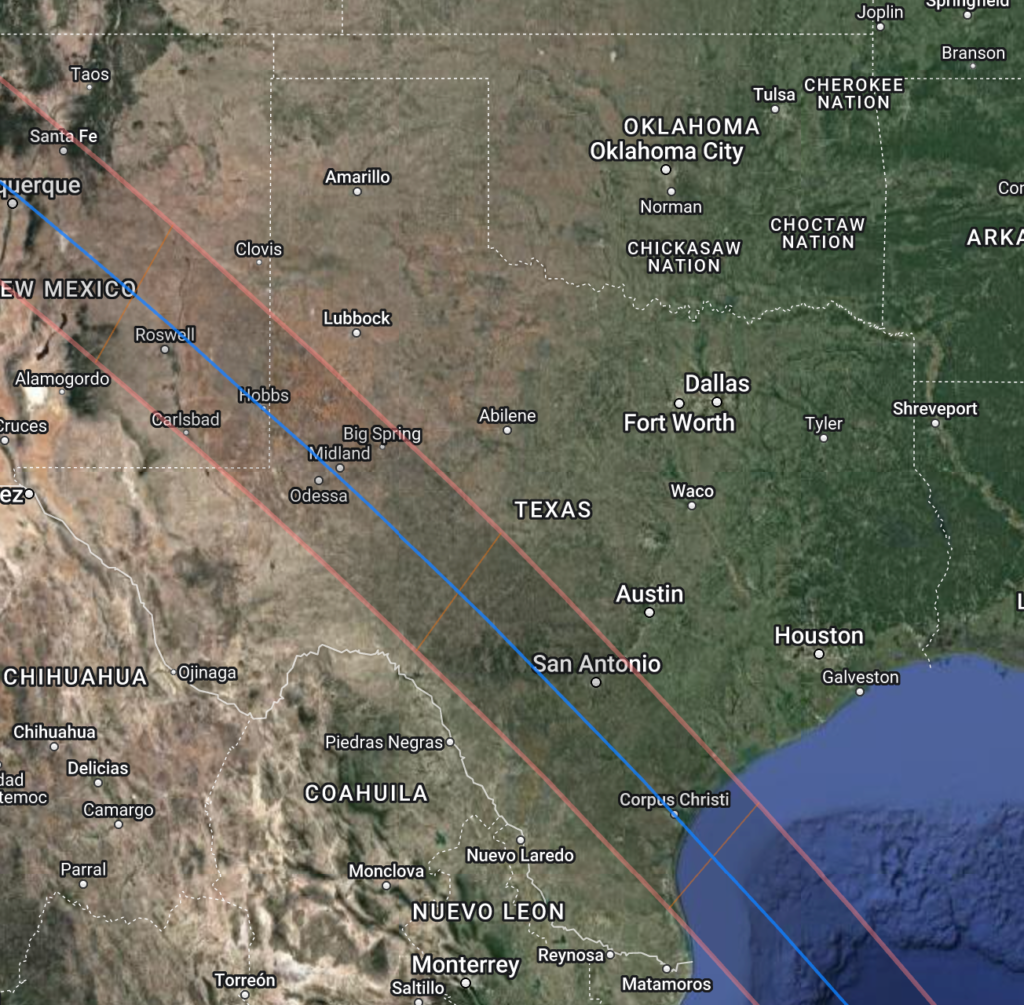
Remember never look directly at the sun with out proper eye protection. Total of the coverage of the sun will only be about 90% even at full Annularity. Special Solar Eclipse Viewers compliant with the ISO Standard for Safe Solar Viewing or the projection methods below are the only safe way to view the partial and annular eclipses. These viewer are available on Amazon – I recommend both the American Paper Wear and Rainbow Symphony Viewers.

Image Credit Google with Xavier M Jubier

If Solar Viewers are unavailable you can use the Projection Method using two pieces of card board. Looking away from the sun, you hold up one cardboard with a hole in it, casting the shadow on the 2nd piece. You’ll can see the moon track over the sun with this projection method.
My favorite is to pull the colander from the kitchen. Again, looking away from the sun, hold up the colander and project the shadow on the ground or white sheet. You can track the progress of the moon occluding the sun, by the half moons projected.

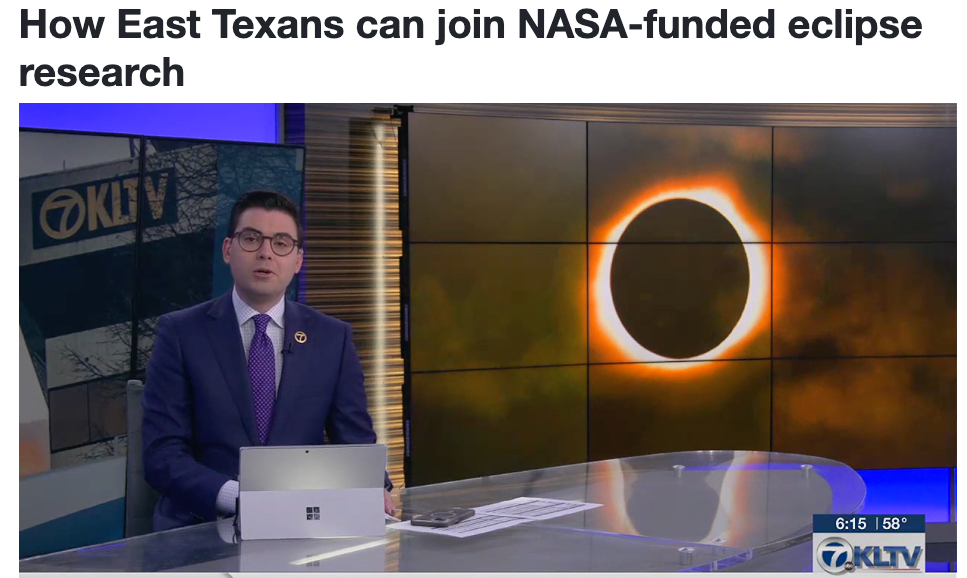
How East Texans can join NASA-funded Eclipse research

Check out this broadcast from KTLV’s Avery Niles Published: Dec. 5, 2023 at 6:49 PM CST
Citizen Continental-America Telescope Eclipse (CATE) will provide next-generation polarized observations during the 2024 total solar eclipse that crosses the United States from Texas to Maine. The network of 60 equally-spaced telescopes along the eclipse path offer a long-duration study of the lower to middle corona. Following the successful observations during the 2017 total solar eclipse, CATE 2024 adds polarization measurements to the science data.
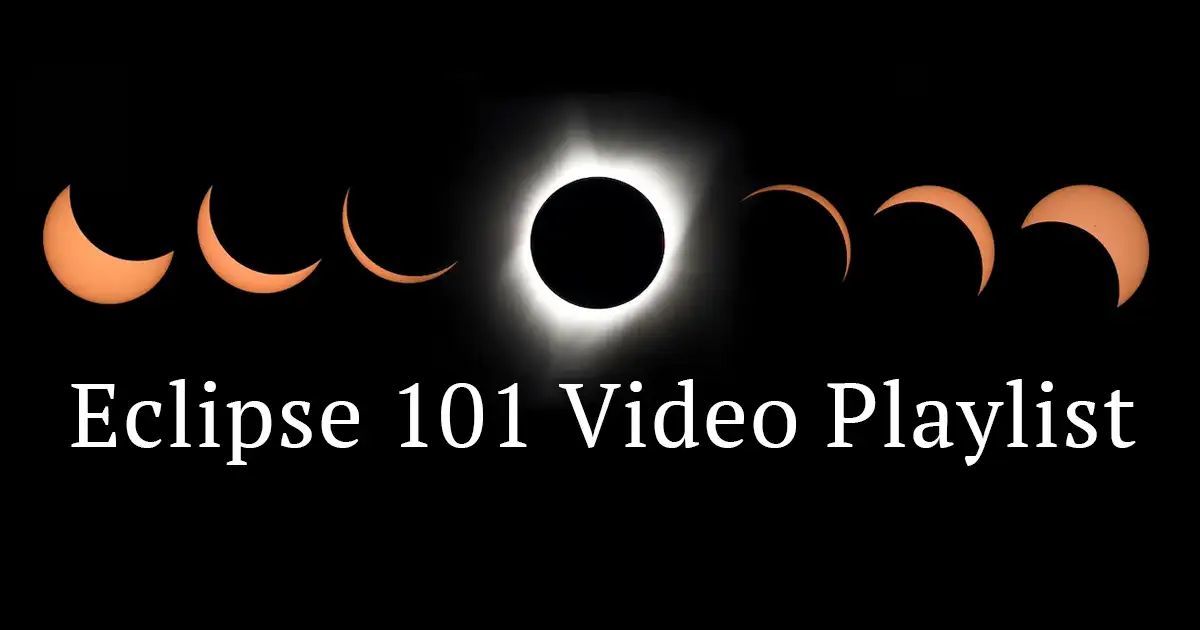
Eclipse 101
This is a compilation of my favorite instructional videos explaining what a Solar Eclipse is.
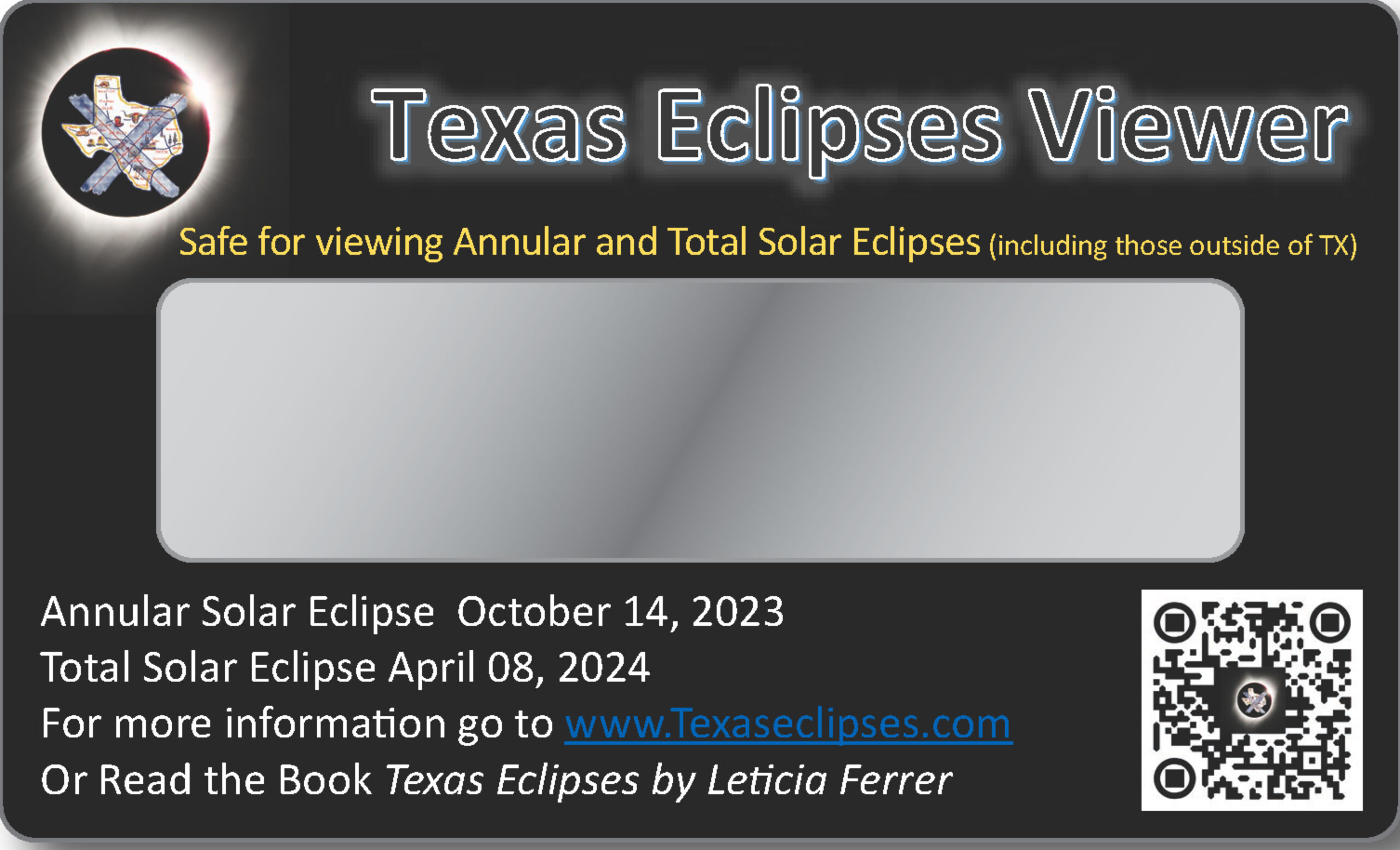
Eye Safety
How to View a Solar Eclipse Safely (courtesy of aas.org)

Looking directly at the Sun is unsafe except during the brief total phase (“totality”) of a total solar eclipse, when the Moon entirely blocks the Sun’s bright face, which happens only within the narrow path of totality. To find out whether your home or any other specific location is within the roughly 115-mile-wide path through Texas on April 8, 2024, North American total solar eclipse, see Xavier Jubier’s Google Map, which supports zooming in to street level.
During a partial or annular (ring) solar eclipse, such as the one coming through Texas on October 14, 2023, there is no time when it is safe to look directly at the Sun without using a special-purpose solar filter that complies with the transmission requirements of the ISO 12312-2 international standard.

The only safe way to look directly at the uneclipsed, partially eclipsed, or annularly eclipsed Sun is through special-purpose solar filters, such as “eclipse glasses” (example shown at left) or handheld solar viewers. Homemade filters or ordinary sunglasses, even very dark ones, are not safe for looking at the Sun; they transmit thousands of times too much sunlight. See the AAS list of Reputable Vendors of Solar Filters & Viewers page for a list of manufacturers and authorized dealers of eclipse glasses and handheld solar viewers verified to be compliant with the transmission requirements of the ISO 12312-2 international safety standard for such products.
Texas Eclipse Viewers are from the premier reputable vendor, Rainbow Symphony, and are verified to be compliant with the ISO 12312-2 international safety standard
Instructions for the safe use of solar filters/viewers:
- Always inspect your solar filter before use; if scratched, punctured, torn, or otherwise damaged, discard it. Read and follow any instructions printed on or packaged with the filter.
- Always supervise children using solar filters.
- If you normally wear eyeglasses, keep them on. Put your eclipse glasses on over them, or hold your handheld viewer in front of them.
- Stand still and cover your eyes with your eclipse glasses or solar viewer before looking up at the bright Sun. After looking at the Sun, turn away and remove your filter — do not remove it while looking at the Sun.
- Do not look at the uneclipsed, partially eclipsed, or annularly eclipsed Sun through an unfiltered camera, telescope, binoculars, or other optical device.
- Similarly, do not look at the Sun through a camera, telescope, binoculars, or any other optical device while using your eclipse glasses or handheld solar viewer — the concentrated solar rays could damage the filter and enter your eye(s), causing serious injury.
- Seek expert advice from an astronomer before using a solar filter with a camera, telescope, binoculars, or any other optical device; note that solar filters must be attached to the front of any telescope, binoculars, camera lens, or other optics.
- If you are inside the path of totality on April 8, 2024, remove your solar filter only when the Moon completely covers the Sun’s bright face and it suddenly gets quite dark. Experience totality, then, as soon as the bright Sun begins to reappear, replace your solar viewer to look at the remaining partial phases. Note that this applies only to viewing without optical aid (other than ordinary eyeglasses). Different rules apply when viewing or imaging the Sun through camera lenses, binoculars, or telescopes; consult an expert astronomer before using a solar filter with any type of magnifying optics.
- Outside the path of totality, and throughout a partial or annular solar eclipse, you must always use a safe solar filter to view the Sun directly.
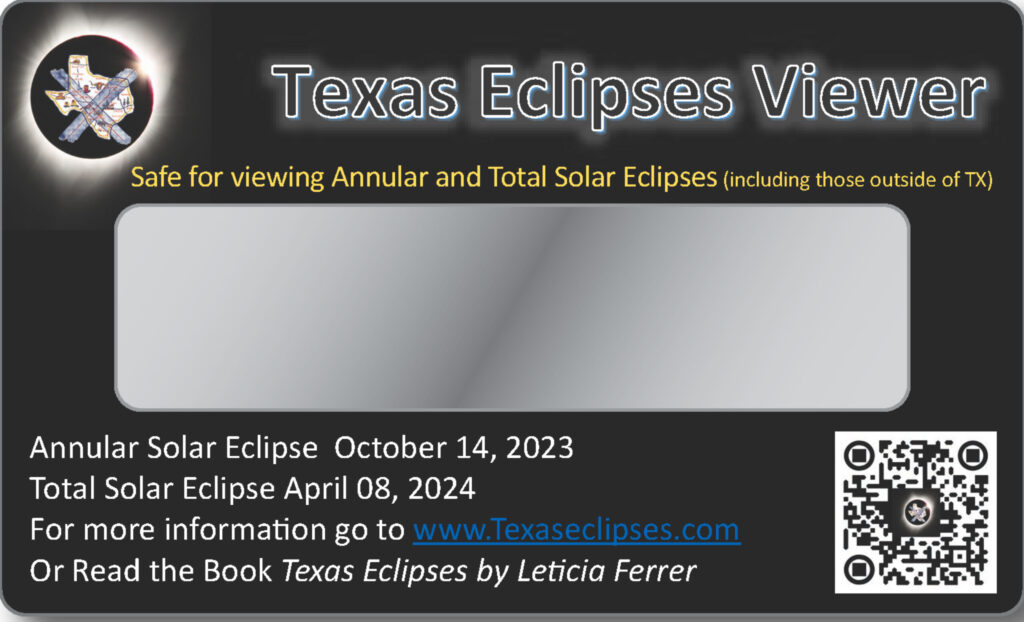
Note: If your eclipse glasses or viewers are compliant with transmission requirements of the ISO 12312-2 safety standard, you may look at the uneclipsed or partially eclipsed Sun through them for as long as you wish. Furthermore, if the filters aren’t scratched, punctured, or torn, you may reuse them indefinitely. Some glasses/viewers are printed with warnings stating that you shouldn’t look through them for more than 3 minutes at a time and that you should discard them if they are more than 3 years old. Such warnings are outdated and do not apply to eclipse viewers manufactured since 2015, compliant with the ISO 12312-2 standard adopted that year, and in excellent condition. To make sure you get (or got) your eclipse glasses/viewers from a supplier of ISO-compliant products, see our Reputable Vendors of Solar Filters & Viewers page or viewers from Texas Eclipses.
An alternative method for safe viewing of the partially eclipsed Sun is indirectly via pinhole projection. I used this method for my very first partial eclipse. For example, cross the outstretched, slightly open fingers of one hand over the outstretched, slightly open fingers of the other, creating a waffle pattern. With your back to the Sun, look at your hands’ shadow on the ground. The little spaces between your fingers will project a grid of small images on the ground, showing the Sun as a crescent during the partial phases of any solar eclipse or as a ring during the annular phase of an annular eclipse. Or just look at the shadow of a leafy tree during a partial or annular eclipse; you’ll see the ground dappled with a crescent or ring-shaped Suns projected by the tiny spaces between the leaves.
A solar eclipse is one of nature’s grandest spectacles. By following these simple rules, you can safely enjoy the view and be rewarded with memories to last a lifetime. I know!! I get my eyes checked every year, after being in the path of 19 Total Solar Eclipses and 2 Annular, I have no damage to my eyes by following the practices on this page. Be Safe!!
This page is courtesy of AAS.org. For more eclipse safety tips from the AAS follow the links below :
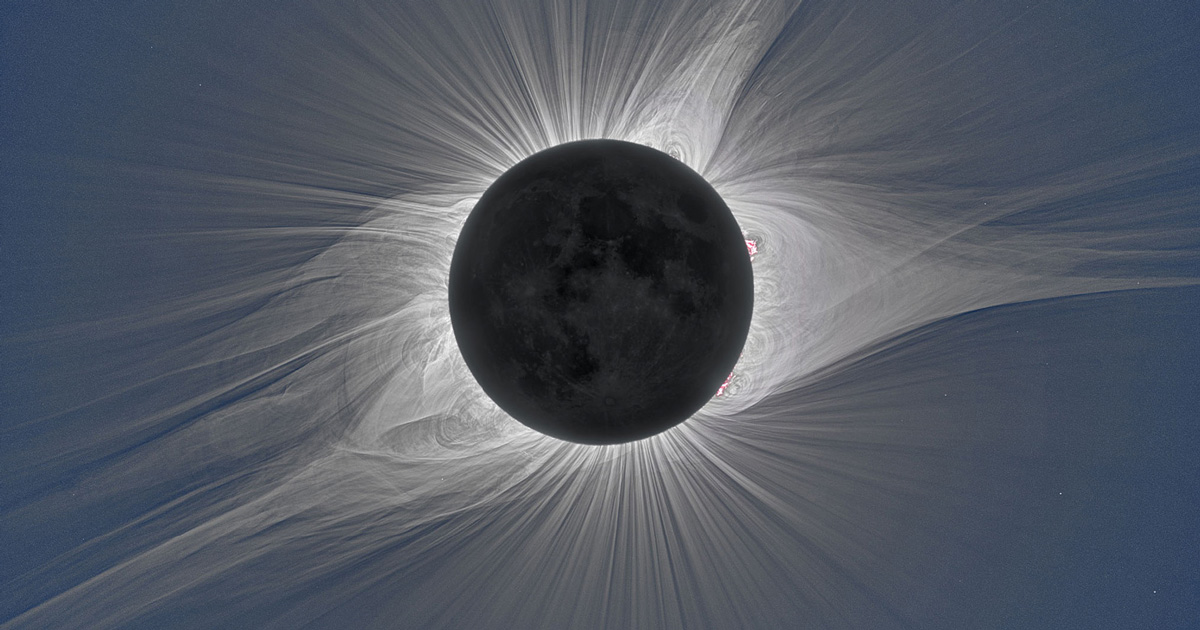
Yea! Texas Eclipses is finally out.

Photo credit NASA – https://solarsystem.nasa.gov/eclipses/home/
You are likely at this webpage because you’re a friend of mine, or someone I worked with in the past. You know my passion for Total Solar Eclipses and my hobby of chasing them all over the planet.
Now, my hobby is coming home, really, right over my house. To help promote the April 08 2024 Total Solar Eclipse and the October 14 2023 Annular Eclipse, I’ve written a small book with a little bit of Texas History about the last major Total Solar Eclipse through Texas on July 11 1878, information about where to go see both eclipses, what to expect when you see an Solar Eclipse and of course Eye Safety.
To celebrate I’m holding a Facebook Live Event from 1:00-2:00 pm on April 08, 2022. Check out my Facebook Texas Eclipses Page for more information.
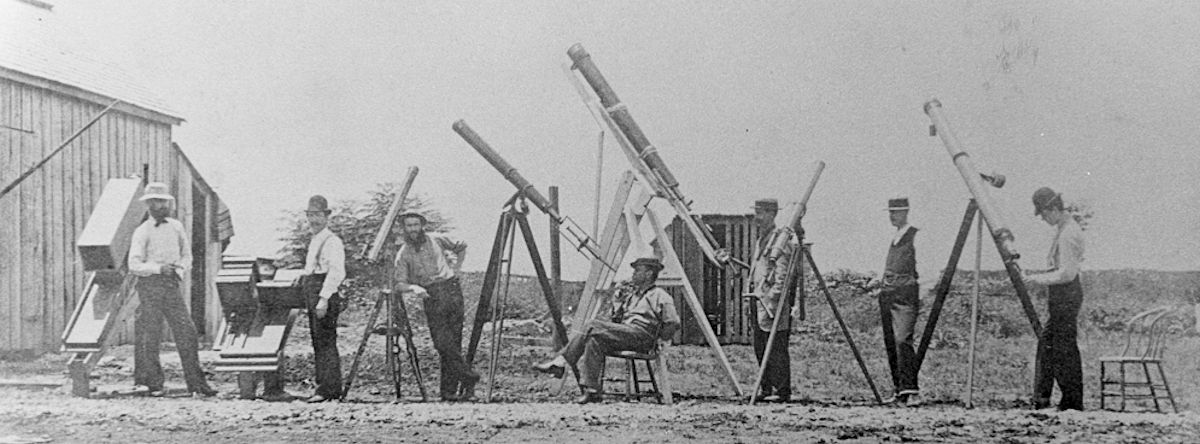
144 years since the last Great Eclipse crossing Texas on July 29, 1878.

Today it is 144 years since the last Great Eclipse crossed Texas on July 29, 1878..
It was the first Total Solar Eclipse was July 29, 1878, since Texas’s founding in 1836. The first time TEXANS experienced a Total Solar Eclipse. Solar Eclipses, both Annular and Total, are as rare in Texas as they are anywhere. The upcoming Total Solar Eclipse of April 08 2024 is only the 3rd Total Solar Eclipse to touch Texas Soil. The other one being on May 28th, 1900 which only crossed the southern tip of Texas and was clouded out.
The July 29, 1878, Total Solar Eclipse path started in Russia, came north through Alaska, through Western Canada, and hit the US starting in the territories (not states) of Montana and Wyoming, through the state of Colorado, the territory of New Mexico, Indian Territory (now Oklahoma), and the state of Texas, ending just before Puerto Rico in the Caribbean. There were scientific parties across the US that day studying the eclipse. Most of them were in the other states of Montana, Wyoming, and Colorado.
Fort Worth, Texas on the frontier, was the centerline for this eclipse. Economically Texas and especially Ft Worth was booming. Progress and strong city leadership made Ft. Worth an attractive option for the eclipse. One reason, Ft Worth had a new railroad station, the train finally arrived in 1876. The Railroad was making Ft. Worth a financial powerhouse. However, Ft. Worth was still the Wild West, where guns were worn as a necessity for defense not only from other men but from the common rattler and other critters. It was a small town with grand ambitions. It had nine churches, nine schools, two militia units, and a dozen physicians. With the economic boom based around cattle and railroad, the town also hosted the infamous “Hell’s Half-Acre,” a designated “Red-Light District.”
To this Wild West Town, a scientific party of five, led by Mr. Leonard Waldo, of Harvard College Observatory arrived to study the eclipse. You can find his report of the eclipse on Amazon or Goodreads, links below this post.
I really enjoyed reading the report. Several things popped out to me when reading.
- The size of the expedition’s equipment, which was carried to the final location on several mules. Although I do know a few current eclipse chasers, such as Milo Slav Druckmuller, who do travel with a team and several vehicles full of equipment.
- Professor Waldo’s very common human reaction when seeing the eclipse. You get lost in the moment, his words, “Just as the time-keeper called two, however, I noticed that I had forgotten to remove my shade-glass, which I now immediately did, regretting that I had lost 15 seconds of precious time.” Professor Waldo had spent months preparing for this moment, his report tell of the drills they ran in preparation. But the experience overwhelmed him.
- The amount of time that Waldo and his team had to spend to determine their location by looking at the stars and aligning their location with Sextants.
- The fact that Waldo did not know what time it is. He or a member of his team spends several evenings trying to get a telegraphic “signal” back to the Washington Observatory in D.C. to set his watch.
- The citizen science that took place. Waldo and his team had help from those in Ft Worth and with the help he garnered during his travels, he included the reports from these citizens in McKinney, Allen, and Dallas. He set up a ‘class’ and gave instructions on how to draw the eclipse to several other citizens, who help with viewing the event.
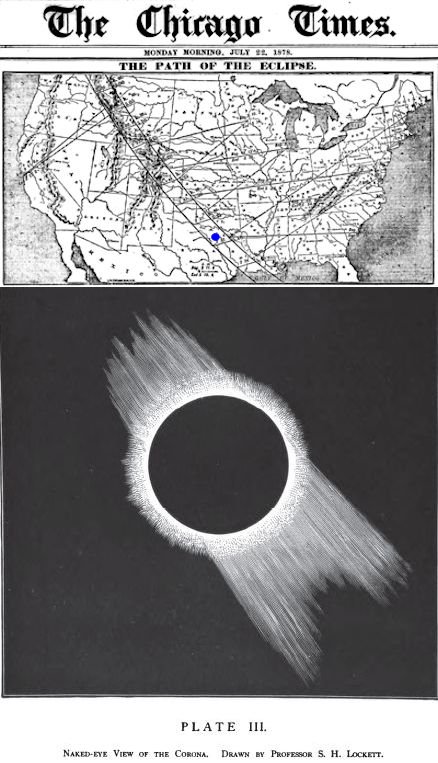
In comparing my travels to what Waldo and the team did to see the eclipse I see the following similarities and differences.
- I am doing 30 hours on transport to get to Exmouth Australia for the April 20, 2023, Total Solar eclipse, Professor Waldo did the same traveling a couple of days by train.
- The camera equipment I have on my phone, far exceeds what was available at the time.
- I still get lost in the moment and forget to remove a cover or aim properly.
- I do know where I am and what time it is.
- Citizen science remains strong as experienced by those in the USA’s last Total Solar Eclipse of August 21, 2017.
If you’d like to read more about this expedition, you can get Professor Waldo’s report on GoodReads or Amazon. Also, there is a great online write-up by a local Ft Worth writer at the website Hometown by Handlebar, History Was Made in the Shade When “Scientists Scooped Old Sol in Pantherville”, the link is below.
Clear Skies,
Leticia Ferrer
July 29, 2022
Report of the Observations of the Total Solar Eclipse, July 29, 1878, Made at Fort Worth, Texas, Ed. by L. Waldo
Amazon: https://amzn.to/3Sel852
GoodReads: https://www.goodreads.com/book/show/26665544-report-of-the-observations-of-the-total-solar-eclipse-july-29-1878-ma
History Was Made in the Shade When “Scientists Scooped Old Sol in Pantherville”: https://hometownbyhandlebar.com/?p=26302
